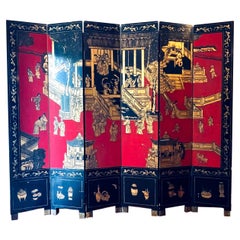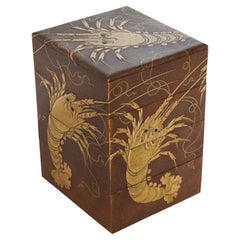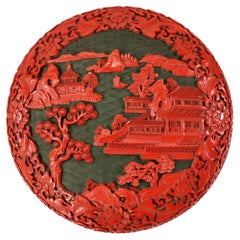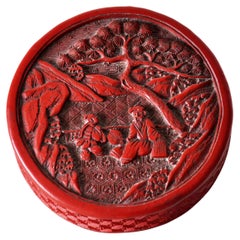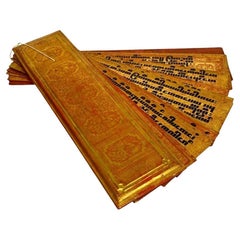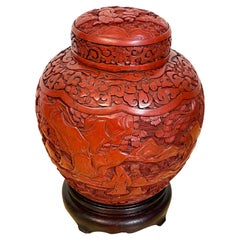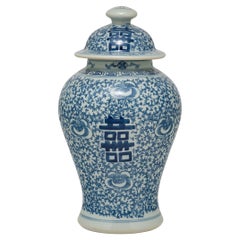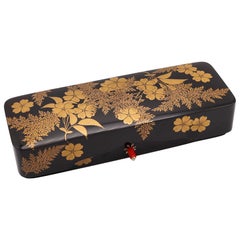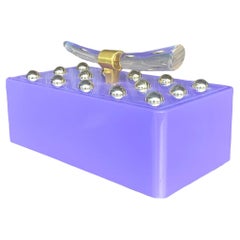Florida - Lacquer
to
8
380
154
27
1
14
12
7
4
1
1
1
1
23
14
6
4
3
27
21
14
7
6
27
27
27
Item Ships From: Florida
Chinese Export Coromandel Lacquer and Gilt Six Fold Screen
Located in Vero Beach, FL
Chinese Export Coromandel lacquer and gilt six fold screen.
Exceptional and rare six panel intaglio lacquer carving from the mid-20th century. It depi...
Category
Mid-20th Century Chinese Chinese Export Florida - Lacquer
Materials
Wood
JAPAN Meiji Period 1870 Four Tiers Presentation Jubako Box Namiki Lacquer & Gold
Located in Miami, FL
Four Tier Japanese Gilt Jubako Maki-E box with red Interior.
This is a beautiful decorative presentation Jubako box created in the Imperial Japan during the early Meiji period (1868...
Category
1870s Japanese Meiji Antique Florida - Lacquer
Materials
Gold
$4,360 Sale Price / set
20% Off
Large Domed Chinese Cinnabar Box
Located in Miami, FL
A large vintage Chinese red cinnabar box with deep relief carved lid depicting peonies, trees and a landscape with a palace. The round box has...
Category
1930s Chinese Chinese Export Vintage Florida - Lacquer
Materials
Brass
Antique Chinese Cinnabar Box
Located in Miami, FL
A fine antique Chinese red cinnabar lacquer lidded round box carved with a scene with a young boy and a seated elderly bearded sage within a rocky landscape with trees. The "dragon's...
Category
19th Century Chinese Qing Antique Florida - Lacquer
Materials
Lacquer
Antique Burmese Kammavaca Script in Lacquer
Located in West Palm Beach, FL
An exceptional 19th-century Burmese Kammavaca manuscript, composed of 14 lacquered palm-leaf-style panels, each meticulously decorated in orange and ...
Category
Late 19th Century Burmese Antique Florida - Lacquer
Materials
Wood, Lacquer
Post Qing Dynasty Cinnabar Ginger Jar & Stand
Located in West Palm Beach, FL
Post Qing Dynasty Cinnabar ginger jar & stand
Exquisite high relief carved continuous landscape motif, complete with hardwood stand. Unmarked.
T...
Category
Early 20th Century Chinese Chinese Export Florida - Lacquer
Materials
Hardwood, Lacquer
$1,196 Sale Price
20% Off
Japan 1800 Edo Period Six Drawer Inro In Lacquered Gilt Wood With Utensils
Located in Miami, FL
Japanese Inro from the Edo Period (1603-1867).
Beautiful Inro, created in Japan during the Edo period (Shogunate), circa 1800. It was carefully crafted in carved precious wood with ...
Category
Early 1800s Japanese Edo Antique Florida - Lacquer
Materials
Coral
$2,600 Sale Price
20% Off
Chinese Soapstone, Semiprecious Hardstone and Lacquer Folding Screen
Located in Miami, FL
This stunning Chinese screen is an exceptionally well-crafted piece, beautifully decorated with intricate semiprecious hardstone carvings. Measuring ...
Category
Mid-20th Century Chinese Chinese Export Florida - Lacquer
Materials
Precious Stone, Wood
Japan 1810 Kajikawa Edo Period Five Drawer Inro Lacquered Gilt Wood With Rooster
Located in Miami, FL
Japanese Inro from the Edo period (1615-1868) created by Kajikawa.
Beautiful Inro, created in Japan by one of the Kajikawa family during the Edo period (1615-1868), circa 1810. Has been carefully crafted in carved precious wood with applications of gilding maki-e and decorated with Japonism patterns. All dan trays are attached together with a himo cord. The detailed craftsmanship was a true pleasure to behold.
Period: Edo period (1615-1868). Shogunate.
Approximate Date: 1790-1810
Motif: A family of birds consisting of a cockerel, the hen and three chicks.
Drawers: Five.
Shape: Rectangular navette.
Technique: Carved wood, lacquer and decorated in iroe-hiramaki-e on a gold ground.
Ojime: 15mm 20mm, oval carved from natural translucent agate.
Netsuke: None
Weight: 47.70 Grams.
Measurements: Inro is 78 mm by 55 mm by 18 mm (3.07 x 2.17 x 0.71 Inches).
Signatures: Kajikawa Saku, in the underside with the signature KAJIKAWA. By a member of the Kajikawa family, signed Kajikawa 梶川 Japan, late 18th century to early 19th century, Edo period (1615-1868).
The Kajikawa family
Kajikawa family, flourished in the 19th century, they was Japanese lacquerware artists whose school in Edo (now Tokyo) flourished for more than 200 years. This family is perhaps the most famous of all the dynasties of Japanese lacquer artists, and certainly the name most often found on inro. The family is said to have been founded by Hikobei at Edo in the early 17th century, although some claim that the family’s great reputation really stemmed from his son and pupil Kyujiro. In any event, Hikobei worked for the shogunate, as did his successors until well into the 19th century. Kijirō excelled in designing particularly delicate lacquer inrō, portable medicine cases...
Category
1810s Japanese Edo Antique Florida - Lacquer
Materials
Agate, Gold
$3,560 Sale Price
20% Off
Japan 1870 Meiji Period Round Five Drawer Inro Lacquered Wood With Flying Cranes
Located in Miami, FL
Japanese Inro from the Meiji Period (1868-1912).
Beautiful Inro, created in Japan during the Meiji imperial period, circa 1870. It was carefully crafted in carved precious wood with applications of lacquer and decorated with orientalism patterns. All dan trays are attached together with a himo cord. The detailed craftsmanship was a true pleasure to behold.
Period: Meiji 1868-1912, Period of Emperor Mutsuhito.
Approximate Date: 1870.
Motif: Organic design with cascade landscape scene and five flying cranes.
Drawers: Five.
Shape: Cylinder. Very unusual and rare shape.
Technique: Carved wood, Lacquer, hiramaki-e, takamaki-e, Gilding.
Ojime: 17mm, round with Ebony wood.
Netsuke: Carved dressed...
Category
1870s Japanese Meiji Antique Florida - Lacquer
Materials
Wood, Ebony, Giltwood, Lacquer
$2,388 Sale Price
20% Off
Chinese Chinoiserie Decorated Lacquer Panels, a Pair
Located in Bradenton, FL
Pair of stylish Chinoiserie panels in a lacquer finish, painted in gold, red & black with landscapes with village and people. The frame also decorat...
Category
19th Century Chinese Chinese Export Antique Florida - Lacquer
Materials
Lacquer
Antique Chinese Cinnabar, Brass and Enamel Box
Located in Miami, FL
A crisply carved antique Chinese red cinnabar lacquer lidded round box with blue enamel interior and brass fittings. The "dragon's blood" trinket box has a fine peony, foliate and fl...
Category
19th Century Chinese Qing Antique Florida - Lacquer
Materials
Brass, Enamel
Chinese Cinnabar Covered Jar, Late 19th Century
By Wang Hing & Co.
Located in Sarasota, FL
Chinese cinnabar covered jar. Decorated all over with scenes of figures, pavilions, pine trees and mountains. Marked "CHINA" on the bottom, circa 1890s.
Category
19th Century Chinese Chinese Export Antique Florida - Lacquer
Materials
Lacquer
19th C. Chinese Figural Carved Wood Lacquer Scholars/ Offering / Opium Stand
Located in West Palm Beach, FL
19th C. Chinese Figural Carved Wood Lacquer Scholars/ Offering / Opium Stand
Chinese 19th Century
A truly unique and remarkable piece from 19th-century China, this figural carved w...
Category
Late 19th Century Chinese Chinese Export Antique Florida - Lacquer
Materials
Shell, Wood, Lacquer
$1,590 Sale Price
20% Off
Early 20th Century Burmese Lacquered Tray, “Pagan Bya”
Located in Atlanta, GA
Burmese (Myanmar) Lacquerware has a long tradition dating back to the 13th century. Lacquer in Burma is called “Thitsi” meaning the sap of a Thitsi Tree (Melanhorrea Usitata). Typica...
Category
Early 20th Century Burmese Florida - Lacquer
Materials
Bamboo, Lacquer
Huge Japanese Red Lacquerware Gourd Motif Box
Located in West Palm Beach, FL
Huge Japanese red lacquerware gourd motif box, decorated in relief with Japanese gourds suspended from leafy branches and scrolling vines.
Category
Early 20th Century Japanese Meiji Florida - Lacquer
Materials
Lacquer
$2,360 Sale Price
20% Off
Early 20th Century Burmese Lacquered Tray, “Pagan Bya”
Located in Atlanta, GA
Burmese (Myanmar) Lacquerware has a long tradition dating back to the 13th century. Lacquer in Burma is called “Thitsi” meaning the sap of a Thitsi Tree (Melanhorrea Usitata). Typica...
Category
Early 20th Century Burmese Florida - Lacquer
Materials
Bamboo, Lacquer
JAPAN 1900 Meiji Period Fubako Box In Hiramaki-e Lacquered Wood With Gilding
Located in Miami, FL
Fubako letters-box from the Japanese Meiji period (1868-1912).
Beautiful decorative Fubako letters box from the Japanese Imperial Meiji period, circa 1900. This box has been meticul...
Category
Early 1900s Japanese Meiji Antique Florida - Lacquer
Materials
Gold
19th Century Chinese Black Lacquer Work Box
Located in Tampa, FL
The 19th century Chinese black lacquer work box has most of the interior with handles on each side. With dragon feet
Category
Late 19th Century Chinese Antique Florida - Lacquer
Materials
Wood, Lacquer
19th Century Chinese Fragment as a Mirror
Located in Tampa, FL
An early 19th century red lacquer with gold accents Chinese fragment with gold courting scenes converted into a mirror. Brass holder for hanging.
Category
Early 19th Century Chinese Antique Florida - Lacquer
Materials
Wood, Lacquer
Chinese Cinnabar Finely Carved Box and Cover, Late 18th-Early 19th Century
By Wang Hing & Co.
Located in Sarasota, FL
Chinese cinnabar very finely carved box circa late 18th or early 19th century. The multiple lacquered layers of red over black over amber, the cover carved with a scene of Kwan Yin i...
Category
1790s Chinese Chinese Export Antique Florida - Lacquer
Materials
Lacquer
Early 20th Century Burmese Lacquer Offering Vessel, Hsun Ok
Located in Atlanta, GA
Burmese (Myanmar) lacquer ware has a long tradition dating back to the 13th century. Lacquer in Burma is called “Thitsi” meaning the sap of a Thitsi Tree (Melanhorrea Usitata). Typically, bamboo and wood are used as a frame or base in making lacquer work.
This covered offering vessel is called a “Hsun Ok...
Category
1920s Burmese Vintage Florida - Lacquer
Materials
Wood, Lacquer
Red Lacquer Chinese Wedding Box- Hand Decorated
Located in West Palm Beach, FL
Chinese red lacquer two part wedding box. Entirely hand decorated with a bird and flowers on top and flowers and vines along the side. The interior is pai...
Category
1890s Chinese Chinoiserie Antique Florida - Lacquer
Materials
Enamel
$680 Sale Price
20% Off
JAPAN 1880 Meiji Period Tebako Box In Red Lacquered Wood With Abalone Inlaid
Located in Miami, FL
Presentation Tebako box from the Japanese Meiji period (1868-1912).
Beautiful decorative presentation Tebako box from the Japanese Imperial Meiji period, circa 1880. This box has been meticulously crafted in a squared cushioned shape in wood with kara coating Kobayashi red lacquer, gilding, black lacquer and inlaid decorations of abalone shell, Raden. Tebako literally means "portable box", it is a toilet box containing the objects necessary for washing and make-up, especially blush mirror...
Category
1880s Japanese Meiji Antique Florida - Lacquer
Materials
Abalone, Wool, Lacquer
Early 20th Century, Large Burmese Betel Box, “Kun It”
Located in Atlanta, GA
Burmese (Myanmar) Lacquerware has a long tradition dating back to the 13th Century. Lacquer in Burma is called “Thitsi” meaning the sap of a Thitsi Tree (Melanhorrea Usitata). Typica...
Category
Early 20th Century Burmese Florida - Lacquer
Materials
Bamboo, Lacquer
Large Asian Black Lacquer Gilt Wood "Bird" Charger on Stand, Hand Painted
Located in Miami, FL
Large Asian Black Lacquer Gilt Wood "Bird" Charger on Stand, Hand Painted
Offered for sale is a large Asian hand-painted gilt-decorated charger on a stand depicting birds and foliag...
Category
Late 20th Century Chinese Chinoiserie Florida - Lacquer
Materials
Wood, Lacquer
Early 20th Century Burmese Lacquered Tray Stand, “Dang lan”
Located in Atlanta, GA
Burmese (Myanmar) lacquer ware has a long tradition dating back to the 13th century. Lacquer in Burma is called “Thitsi” meaning the sap of a Thitsi Tree (Melanhorrea Usitata). Typically, bamboo and wood are used as a frame or base in making lacquer work.
This table tray stand called a “Dang lan” and is used to hold dishes...
Category
Mid-20th Century Burmese Florida - Lacquer
Materials
Bamboo, Lacquer
Related Items
Blue and White Double Happiness Ginger Jar
Located in Chicago, IL
The symbol for double happiness adorns this slender ginger jar with best wishes for love, companionship and marital bliss. Glazed in the classic blue and white manner, the porcelain ...
Category
21st Century and Contemporary Chinese Chinese Export Florida - Lacquer
Materials
Porcelain
Islamic Antique Qajar Blue Tile with Koranic Script 19th C.
Located in North Hollywood, CA
Antique 19th century Qajar blue tile with Islamic calligraphy writing.
Antique 19th century Islamic Koranic calligraphy with Koranic script.
Qajar dynasty, a blue and white Islamic ...
Category
19th Century Turkish Islamic Antique Florida - Lacquer
Materials
Ceramic, Pottery
Large Chinese 4-Fold Hardwood Screen inset with Blue & White Porcelain Plaques
Located in New York, NY
A large Chinese four-fold hardwood screen inset with blue and white porcelain plaques. The hand carved wood frame is a very dense and n...
Category
Early 1900s Chinese Qing Antique Florida - Lacquer
Materials
Porcelain, Hardwood
$28,800
H 70 in W 72 in D 2 in
18th/19th Century Chinese Cinnabar Circular Box with Multiple Cartouches
Located in New York, NY
An 18th/19th Century Chinese cinnabar circular box with multiple cartouches of Families. This is a marvelous piece with very fine details on the main top panel of the box. The top pa...
Category
1790s Chinese Qing Antique Florida - Lacquer
Materials
Lacquer
Japanese Namban Lacquer and Inlay Coffer Momoyama Period
Located in Atlanta, GA
A rare Japanese Namban Lacquer domed coffer circa 1570-1610s of Azuchi-Momoyama to early Edo period. These types of lacquerware were made for export to ...
Category
16th Century Japanese Japonisme Antique Florida - Lacquer
Materials
Wood, Lacquer
Japanese Lacquer Ryoshibako Document Box Meiji Period
Located in Atlanta, GA
A large Japanese lacquer box with elaborate Maki-e design from Meiji period, (mid-late 19th century). The generous size of the box was reser...
Category
19th Century Japanese Japonisme Antique Florida - Lacquer
Materials
Wood, Lacquer
Antique Japanese Lacquer Stacking Food Box 'Jubako'
Located in Hudson, NY
With all-over mother of pearl inlay and mon design of chrysanthemum in gold and black lacquer on top. The chrysanthemum is a national symbol of Japan and the Imperial family.
Category
19th Century Japanese Antique Florida - Lacquer
Materials
Gold
Chinese Export Lacquered Six Panel Coromandel Landscape Screen
Located in Rio Vista, CA
Beautifully weathered patina Chinese export lacquered coromandel screen with six double sided panels. The screen features a mountain landscape on one si...
Category
20th Century Chinese Chinese Export Florida - Lacquer
Materials
Brass
Japanese Maki-e Lacquer Stack Box Jubako
Located in Atlanta, GA
An antique jubako (stack boxes) with five tiers in an elongated octagon shape circa 19th century (end of Edo or beginning of Meiji period). jubako was traditionally used to store and...
Category
19th Century Japanese Japonisme Antique Florida - Lacquer
Materials
Wood, Lacquer
Chinese Export Four Panel Carved Soapstone Coromandel Screen
Located in Rio Vista, CA
Impressive Chinese export four panel lacquered coromandel screen featuring hand-carved soapstone beauties in a floral landscape with gilt clo...
Category
20th Century Chinese Chinese Export Florida - Lacquer
Materials
Soapstone, Brass
Vintage Four Panel Lacquer and Carved Hardstone Screen
Located in Vancouver, British Columbia
An early 20th century Asian black lacquer screen with carved coloured hardstone figures and scenery.
Category
1950s French Chinoiserie Vintage Florida - Lacquer
Materials
Stone
$3,960 Sale Price
20% Off
H 48 in W 48 in D 1 in
Chinese Export Six Panel Coromandel Screen Gilt Courtyard
Located in Rio Vista, CA
Stunning 20th century Chinese export lacquered six-panel coromandel screen depicting a lush courtyard over a dramatic gold leaf ground. The lacquered panels are incised and painted w...
Category
20th Century Chinese Chinese Export Florida - Lacquer
Materials
Brass
Previously Available Items
JAPAN 1900 Meiji Fubako Box In Hiramaki-e Lacquered Black Wood With Gilding
Located in Miami, FL
Fubako letters-box from the Japanese Meiji period (1868-1912).
Beautiful decorative Fubako letters box from the Japanese Imperial Meiji period, circa 1900. This box has been meticulously crafted in wood with black lacquer and gilding decorations. The long sides are attached with a pair of carvings in coral and gilded sterling silver screws.
Created in an elongated rectangular shape with sharp corners, the outside of the lid has decorations in hiramaki-e depicting decorations of Sakura cherry blossom flowers in high relief. The interior part of the lid and the inside of the lower box are fundame lacquered with applications of very fine gold powder.
The Meiji Imperial Period
This is an era of Japanese history that extended from October 23, 1868 to July 30, 1912.The Meiji era was the first half of the Empire of Japan, when the Japanese people moved from being an isolated feudal society at risk of colonization by Western powers to the new paradigm of a modern, industrialized nation state and emergent great power, influenced by Western scientific, technological, philosophical, political, legal, and aesthetic ideas. As a result of such wholesale adoption of radically different ideas, the changes to Japan were profound, and affected its social structure, internal politics, economy, military, and foreign relations. The period corresponded to the reign of Emperor Meiji. It was preceded by the Keiō era and was succeeded by the Taishō era, upon the accession of Emperor Taishō.
Fubako
This is a kind of box. It has been used to store letters, papers, or books, and it is also used to deliver documents to the other party. It is useful not only to store documents or books, but you can also put your favorite small articles or valuables. Or, you can also display it to enjoy as a part of the interior decoration in your room.
Hiramaki-e
This term is in reference to a Japanese lacquer work, gold decoration in low, or “flat,” relief, a basic form of Makie-e. The pattern is first outlined on a sheet of paper with brush and ink. It is then traced on the reverse side of the paper with a mixture of heated wet lacquer and (usually red) pigment. The artist transfers the pattern directly to the desired surface by rubbing with the fingertips, a process called okime. In the next step (jigaki), the pattern that has been transferred is painted over with lacquer—usually a reddish colour. A dusting tube is used to sprinkle gold powder on the painted design while the lacquer is still wet.
Makie-e
This is another more complicated technique of Japanese lacquer art...
Category
Early 1900s Japanese Meiji Antique Florida - Lacquer
Materials
Gold
H 1.75 in W 9.31 in D 3.52 in
Vintage Contemporary Lacquered Box With Lucite Horn Handle
Located in West Palm Beach, FL
A chic vintage Contemporary lacquered box. A brilliant purple color with a lucite horn handle and gold hardware. Acquired from a Palm Beach estate.
Category
Late 20th Century Mid-Century Modern Florida - Lacquer
Materials
Gold
19th Century Chinese Export Oval Cinnabar Box
Located in West Palm Beach, FL
19th Century Chinese Export Oval Cinnabar Box
This 19th Century Chinese Export Oval Cinnabar Box is a testament to exceptional craftsmanship and artistr...
Category
19th Century Chinese Chinese Export Antique Florida - Lacquer
Materials
Metal
Japan 1810 Edo Period Takamaki-e Five Drawer Inro In Lacquered Wood With A Hawk
Located in Miami, FL
Japanese Inro with a Hawk from the Edo Period (1603-1867).
Beautiful Inro, created in Japan during the Edo period (Shogunate), circa 1810. It was carefully crafted in carved preciou...
Category
1810s Japanese Edo Antique Florida - Lacquer
Materials
Coral, Silver
H 3.5 in W 1.62 in D 1.5 in
Japan 1830 Edo Period Six Drawer Inro In Lacquered Gilt Wood With A Carriage
Located in Miami, FL
Japanese Inro from the Edo Period (1603-1867).
Beautiful Inro, created in Japan during the Edo period (Shogunate), circa 1830. It was carefully crafted in carved precious wood with applications of lacquer and decorated with orientalism patterns. All dan trays are attached together with a himo cord. The detailed craftsmanship was a true pleasure to behold.
Period: Edo 1606-1867, Shogunate.
Approximate Date: 1830
Motif: An elaborated three-dimensional royal carriage with a silvered bull and a richly dressed court companion. All surrounded by a road and sinuous mountainous landscape with trees and plants.
Drawers: Six.
Shape: Oval
Technique: Carved wood, Lacquer, hiramaki-e, takamaki-e, Gilding, Silvered.
Ojime: 15mm, round sphere carved from natural translucent carnelian
Netsuke: Patinated carved seated child playing a shakuhachi (flute) in a resting bull, signed.
Weight: 67.60 Grams.
Measurements: Inro is 92 mm by 27 mm by 38 mm (3.60 x 1.06 x 1.50 Inches).
The Edo Period
The Edo period or Tokugawa period is the period between 1603 and 1867 in the history of Japan, when Japan was under the rule of the Tokugawa shogunate and the country's 300 regional daimyo. Emerging from the chaos of the Sengoku period, the Edo period was characterized by economic growth, strict social order, isolationist foreign policies, a stable population, perpetual peace, and popular enjoyment of arts and culture. The period derives its name from Edo (now Tokyo), where on March 24, 1603, the shogunate was officially established by Tokugawa Ieyasu. The period came to an end with the Meiji Restoration and the Boshin War, which restored imperial rule to Japan. The Tokugawa (or Edo) period brought 250 years of stability to Japan. The political system evolved into what historians call bakuhan, a combination of the terms bakufu and han (domains) to describe the government and society of the period.[3] In the bakuhan, the shōgun had national authority and the daimyo had regional authority. This represented a new unity in the feudal structure, which featured an increasingly large bureaucracy to administer the mixture of centralized and decentralized authorities. The Tokugawa became more powerful during their first century of rule: land redistribution gave them nearly seven million koku, control of the most important cities, and a land assessment system reaping great revenue
Inro
Is a traditional Japanese case for holding small objects, suspended from the obi (sash) worn around the waist when wearing a kimono. They are often highly decorated with various materials such as lacquer and various techniques such as maki-e, and are more decorative than other Japanese lacquerware. Because traditional Japanese dress...
Category
1830s Japanese Edo Antique Florida - Lacquer
Materials
Gold, Silver
H 3.6 in W 1.5 in D 1.06 in
19th Century Japanese Chinoiserie Lacquer Chest
Located in Bradenton, FL
19th century Japanese chinoiserie painted gold lacquer. chest with brass handle. Chest depicts Japanese countryside and mountains in raised chinoi...
Category
Early 20th Century Japanese Anglo-Japanese Florida - Lacquer
Materials
Wood
Chinese Cinnabar Vase with Finely Carved Foo Dogs, 19th Century
By Wang Hing & Co.
Located in Sarasota, FL
Chinese cinnabar finely carved vase with depiction of the foo dogs, 19th century.
Category
Mid-19th Century Chinese Chinese Export Antique Florida - Lacquer
Materials
Lacquer
Chinese Export Carved Cinnabar 'Acrobats' Display Plate, & Stand
Located in West Palm Beach, FL
Chinese Export Carved Cinnabar 'Acrobats' Display Plate, & Stand
China, 20th century
Depicting four Chinese Acrobats performing in landscap...
Category
20th Century Chinese Chinese Export Florida - Lacquer
Materials
Hardwood, Lacquer
Japan 1900 Meiji Miniature Hanagamidai Cabinet in Gilded Wood & Sterling Silver
Located in Miami, FL
Miniature hanagamidai cabinet from the Japan meiji (1858-1912) period.
Gorgeous and rare miniature drawers hanagamidai (cosmetic cabinet), created in the imperial Japan during the...
Category
Early 1900s Japanese Meiji Antique Florida - Lacquer
Materials
Gold, Silver, Sterling Silver
H 10.25 in W 9.12 in D 7.13 in
Antique 19th Century Chinese Gilt Lacquer Sewing Table
Located in Delray Beach, FL
Beautiful antique 19th century Chinese lacquer sewing table with hand painted vivid scenes, decorative hand carved and painted legs, open ...
Category
Mid-19th Century Chinese Antique Florida - Lacquer
Materials
Wood, Lacquer
Exquisite Meiji Period Gilt Lacquered and Brass Mounted Stand
Located in West Palm Beach, FL
Exquisite Meiji period gilt lacquered and brass-mounted stand, of rectangular form with engraved brass mounts, beautiful floral carving. Great for bonsai trees, unmarked.
Category
Early 20th Century Japanese Meiji Florida - Lacquer
Materials
Lacquer
French Asian Style Lacquered Cocktail Table, circa 1950
Located in Locust Valley, NY
French Asian style lacquered mahogany cocktail table in deep red hue with floral decorated top and straight legs, circa 1950.
Category
Mid-20th Century French Florida - Lacquer
Materials
Lacquer
Recently Viewed
View AllMore Ways To Browse
Nagasaki Lacquer
Negoro Lacquer
Japanese Cinnabar
Japanese Lacquer Comb
Japanese Sake Set Antique
Lacquer Hibachi
Cinnabar Dragon
Japanese Bako
Antique Japanese Lacquer Kobako
Burmese Offering Bowl
Japanese Negoro Lacquer
Japanese Hat Box
Chinese Cinnabar Dragons
Japanese Laquered
Japanese Water Droppers
Namban Lacquer
Japanese Ojime
Japanese Suzuribako
